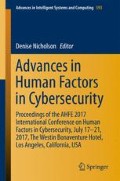Abstract
This paper explores the interaction of humans and autonomous, intelligent agents working together as teammates in cyberspace operations. Though much research has investigated human-machine teams in domains such as robotics, there is a dearth of research into human-agent dynamics in cyberspace operations Some challenges are similar, such as trust between human and agent. Other challenges, such as representation and interface, are unique to cyberspace given that topological, logical, and temporal relationships are first class constructs with different semantic interpretations from their counterpart visual and spatial representations that are prevalent in physical domains. These challenges arise as the software behaves less like a tool and increasingly becomes more like a synthetic teammate.
Access this chapter
Tax calculation will be finalised at checkout
Purchases are for personal use only
References
Lathrop, S.D., Trent, S., Hoffman, R.: Applying human factors research towards cyberspace operations: a practitioner’s perspective. In: Advances in Human Factors in Cybersecurity, pp. 281–293. Springer (2016)
Joint Publication 3–12, Cyberspace Operations (2013)
Lee, R.M., Assante, M.J., Conway, T.: Analysis of the cyber attack on the Ukrainian power grid (Traffic Light Protocol (TLP) White). Electrical Information Sharing and Analysis Center (2016)
The Department of Defense Cyber Strategy (2015). http://www.defense.gov/Portals/1/features/2015/0415_cyber-strategy/Final_2015_DoD_CYBER_STRATEGY_for_web.pdf
Toussain, M.: Home-Field Advantage: Using Indicators of Compromise to Hunt Down the Advanced Persistent Threat. SANS Institute InfoSec Reading Room (2014)
Cyber Threat Hunting. https://sqrrl.com/solutions/cyber-threat-hunting/
Newhouse, B., Keith, S., Schribner, B., Witte, G.: NIST SP 800-181, NICE Cybersecurity Workforce Framework, National Initiative for Cybersecurity Education (Draft) (2016)
Jones, R.M., O’Grady, R., Nicholson, D., Hoffman, R., Bunch, L., Bradshaw, J., Bolton, A.: Modeling and integrating cognitive agents within the emerging cyber domain. In: Interservice/Industry Training, Simulation, and Education Conference (I/ITSEC), vol. 20 (2015)
Abbass, H.A., Petraki, E., Merrick, K., Harvey, J., Barlow, M.: Trusted autonomy and cognitive cyber symbiosis: open challenges. Cogn. Comput. 8(3), 385–408 (2016)
Sycara K, Lewis M. Integrating intelligent agents into human teams. In: Salas, E., Fiore, S., (eds.) Team Cognition: Process and Performance at the Inter and Intra-individual Level, Washington. American Psychological Association (2004)
Huang, L., Antony, J.D., Nelson, B., Rubinstein, B.I.P., Tygar, J.D.: Adversarial machine learning. In: The 4th ACM Workshop on Artificial Intelligence and Security, Chicago, IL (2011)
Riley, M., Elgin, B., Lawrence, D., Matlack, C.: Missed Alarms and 40 Million Stolen Credit Card Numbers: How Target Blew It, Bloomberg.com (2016). http://www.bloomberg.com/news/articles/2014-03-13/target-missed-warnings-in-epic-hack-of-credit-card-data. Accessed 9 Apr 2016
Laird, J.E.: The Soar Cognitive Architecture. MIT Press, Cambridge (2012)
Lathrop, S.D., Wintermute, S., Laird, J.E.: Exploring the functional advantages of spatial and visual cognition from an architectural perspective. Top. Cogn. Sci. 3(4), 796–818 (2010)
Conti, G.: Security Data Visualization: Graphical Techniques for Network Analysis. No Starch Press, San Francisco (2007)
Taylor, G., Purman, B., Schermerhorn, P., Garcia-Sampedro, G., Lanting, M., Quist, M., Kawatsu, C.: Natural interaction for unmanned systems. In: SPIE Defense+Security, pp. 946805–946805. International Society for Optics and Photonics (2015)
Beitzel, S., Dykstra, J., Huver, S., Kaplan, M., Loushine, M., Youzwak, J.: Cognitive performance impact of augmented reality for network operations tasks. In: Advances in Human Factors in Cybersecurity, pp. 139–151. Springer (2016)
Author information
Authors and Affiliations
Corresponding author
Editor information
Editors and Affiliations
Rights and permissions
Copyright information
© 2018 Springer International Publishing AG
About this paper
Cite this paper
Lathrop, S.D. (2018). Interacting with Synthetic Teammates in Cyberspace. In: Nicholson, D. (eds) Advances in Human Factors in Cybersecurity. AHFE 2017. Advances in Intelligent Systems and Computing, vol 593. Springer, Cham. https://doi.org/10.1007/978-3-319-60585-2_14
Download citation
DOI: https://doi.org/10.1007/978-3-319-60585-2_14
Published:
Publisher Name: Springer, Cham
Print ISBN: 978-3-319-60584-5
Online ISBN: 978-3-319-60585-2
eBook Packages: EngineeringEngineering (R0)

